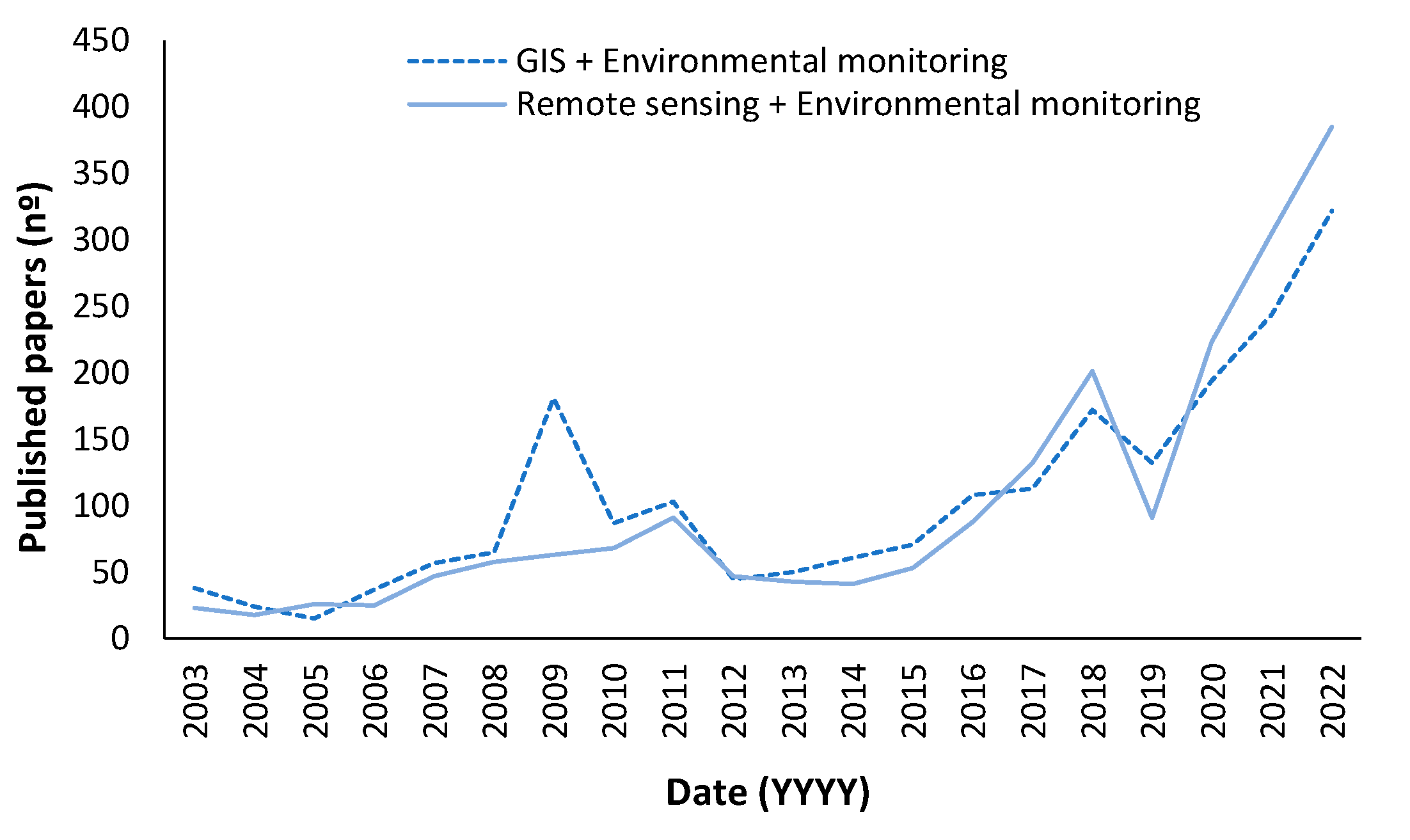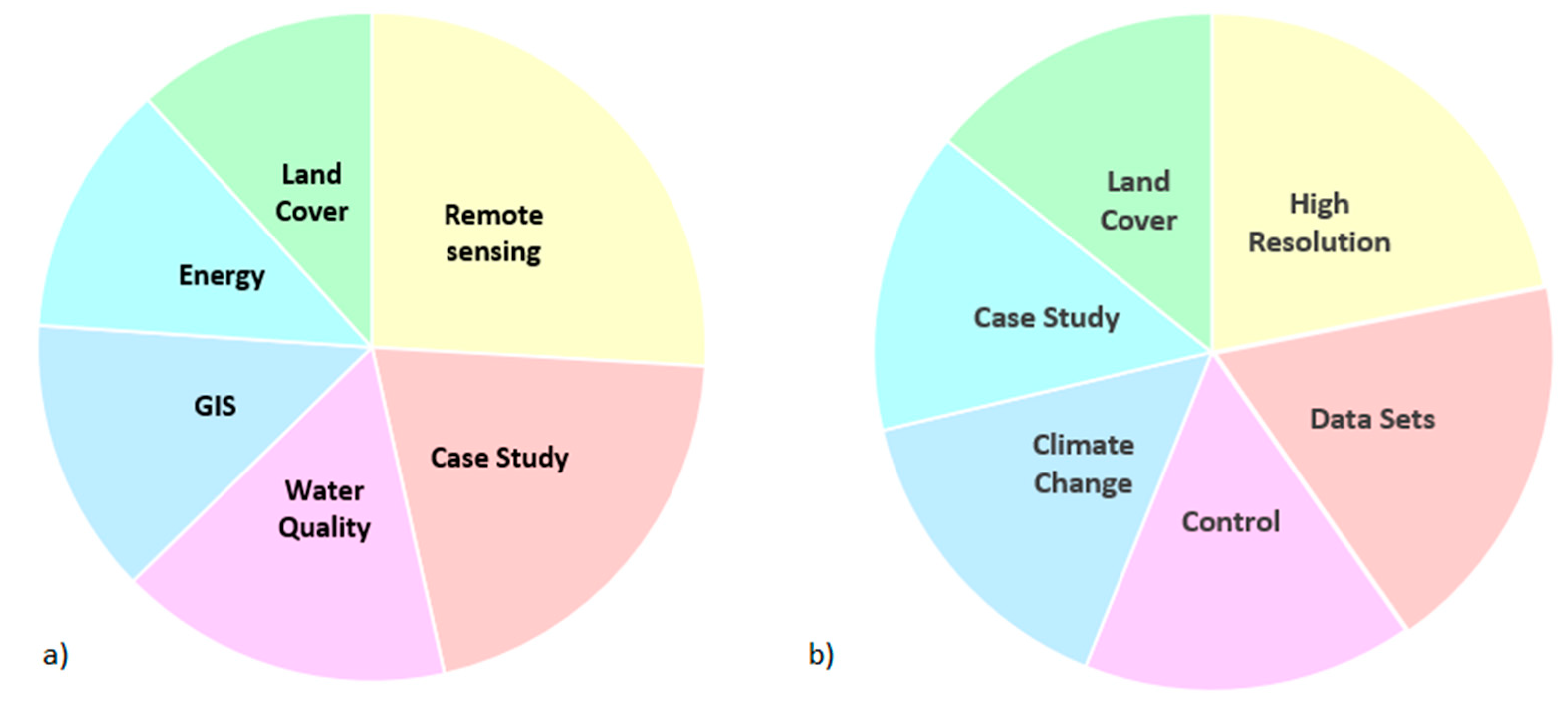Remote Sensing and GIS in Environmental Monitoring
1. Introduction
2. General Uses of Remote Sensing and GIS in Environmental Monitoring
3. Remote Sensing Image Sources
4. Included Application Cases
5. Current Challenges and Future Trends
- Current problems related to the low use of UAVs: In this Special Issue, we encountered that most of the papers are based on satellite image sources. Nonetheless, we expect that in the near future, drones will have an even more relevant role in remote sensing and the digitalization of different environmental aspects. In fact, UAVs have appeared as a relevant subtopic in remote sensing and environmental monitoring papers in the last three years, as seen in Figure 3. The inclusion of multispectral or hyperspectral cameras in the drones will allow better environmental monitoring. Similar to the inclusion of multispectral cameras, the inclusion of other capabilities such as light detection and ranging (LiDAR) or radar sensing systems might be included in UAVs in the next few years. The last limitation identified through the review of the literature is the low battery time of these devices, especially of the smallest and cheapest ones. Since the efficiency of existing energy harvesting systems does not allow for their inclusion in the UAVs to expand their battery life, new options should probably be studied. The topic of energy limitation on drones was recently studied in [26], in which the authors conclude that drone-to-drone charging or fuel-based drones might be some of the possible solutions.
- Future challenges linked to the higher use of UAVs: One of the major problems related to UAV use is that due to the great variability of environmental conditions, constraints, and variables, the proposed solutions might only be applied in other cases. Thus, it is almost impossible to develop operation algorithms which can be applied universally under all scenarios [27]. Nonetheless, it is important to follow a systematic approach in order to find the best practices to be applied in other use cases. Combining images from satellites or drones with on-land or underground sensors such as Internet of Things devices will create diverse and heterogeneous networks that will provide data for different uses. The data we will have in the future, characterized by higher resolutions and the joining together of different data sources, will be used for new applications which are currently unexploited. Since we cannot foresee the characteristics or requirements for future applications, identifying the best practices and continuing systematic approaches to the current case studies is essential. Nonetheless, some examples include how remote sensing and on-ground sensors are used for detecting and verifying wildfires [28].
- The storage problem and its relationship with energy: One of the future challenges that we will need to face in this area, particularly linked to the use of UAVs, will be the storage requirements needed to save all the generated data. The storage and operational requirements for analyzing vast volumes of monitoring data were already mentioned for GIS systems in [29] in 2016. The use of multispectral cameras in combination with land-based sensors and LiDAR will exacerbate the problems related to storage requirements. It must be noted that storing, processing, and particularly, sending data are activities with high energy consumption. Recently, some scientists have included their carbon footprint in data management [30]. Therefore, we can expect certain sorts of limitations in the future regarding data storage. Minimizing the stored and analyzed data without reducing the information contained in the data will be essential. Some efforts in this area can be seen in [31].
- GIS and data visualization: The way in which data is presented to the end-users and the stakeholders is very important. To maximize the impact of the research about remote sensing and GIS on society, the visualization of data in the correct environment is very important. Most of the current software used to analyze the data is not optimal for data visualization. Some efforts are made in several papers to try and create user-friendly and flexible computing environments, such as [32].
- Intelligent UAVs and real-time data analyses: Another aspect that will modify how remote sensing and GIS are used for environmental monitoring is the inclusion of adaptative and intelligent operation algorithms in the UAVs. Nowadays, most UAVs are being operated remotely by a person. The advances in autonomous vehicles will soon impact the autonomous flying of UAVs. Including this artificial intelligence will enhance the monitoring capabilities of these devices. They will be able to adjust their operation (flying velocity or flying height) according to the results of the gathered images. To do so, we will need powerful computational capability nodes in the UAVs that can analyze the gathered images in real time to decide if they need to modify their operational algorithm.
Funding
Conflicts of Interest
References
- World Wide Science Website. Available online: https://worldwidescience.org/ (accessed on 26 July 2022).
- Chawla, I.; Karthikeyan, L.; Mishra, A.K. A review of remote sensing applications for water security: Quantity, quality, and extremes. J. Hydrol. 2020, 585, 124826. [Google Scholar] [CrossRef]
- Wei, X.; Chang, N.B.; Bai, K.; Gao, W. Satellite remote sensing of aerosol optical depth: Advances, challenges, and perspectives. Crit. Rev. Environ. Sci. Technol. 2020, 50, 1640–1725. [Google Scholar] [CrossRef]
- Babaeian, E.; Sadeghi, M.; Jones, S.B.; Montzka, C.; Vereecken, H.; Tuller, M. Ground, proximal, and satellite remote sensing of soil moisture. Rev. Geophys. 2019, 57, 530–616. [Google Scholar] [CrossRef]
- Sishodia, R.P.; Ray, R.L.; Singh, S.K. Applications of remote sensing in precision agriculture: A review. Remote Sens. 2020, 12, 3136. [Google Scholar] [CrossRef]
- Pérez-Castro, M.Á.; Schubert, N.; De Oca, G.A.M.; Leyte-Morales, G.E.; Eyal, G.; Hinojosa-Arango, G. Mesophotic Coral Ecosystems in the Eastern Tropical Pacific: The current state of knowledge and the spatial variability of their depth boundaries. Sci. Total Environ. 2022, 806, 150576. [Google Scholar]
- Lechner, A.M.; Foody, G.M.; Boyd, D.S. Applications in remote sensing to forest ecology and management. One Earth 2020, 2, 405–412. [Google Scholar] [CrossRef]
- Noor, N.M.; Abdullah, A.; Hashim, M. Remote sensing UAV/drones and its applications for urban areas: A review. In IOP Conference Series: Earth and Environmental Science; No. 1; IOP Publishing: Bristol, UK, 2018; Volume 169, p. 012003. [Google Scholar]
- Estoque, R.C. A review of the sustainability concept and the state of SDG monitoring using remote sensing. Remote Sens. 2020, 12, 1770. [Google Scholar] [CrossRef]
- Trofymchuk, O.; Klymenko, V.; Anpilova, Y.; Sheviakina, N.; Zagorodnia, S. The aspects of using GIS in monitoring of environmental components. Int. Multidiscip. Sci. GeoConf. SGEM 2020, 20, 581–588. [Google Scholar]
- Manfreda, S.; McCabe, M.F.; Miller, P.E.; Lucas, R.; Pajuelo Madrigal, V.; Mallinis, G.; Toth, B. On the use of unmanned aerial systems for environmental monitoring. Remote Sens. 2018, 10, 641. [Google Scholar] [CrossRef]
- El Mahrad, B.; Newton, A.; Icely, J.D.; Kacimi, I.; Abalansa, S.; Snoussi, M. Contribution of remote sensing technologies to a holistic coastal and marine environmental management framework: A review. Remote Sens. 2020, 12, 2313. [Google Scholar] [CrossRef]
- Reinermann, S.; Asam, S.; Kuenzer, C. Remote sensing of grassland production and management—A review. Remote Sens. 2020, 12, 1949. [Google Scholar] [CrossRef]
- Li, J.; Pei, Y.; Zhao, S.; Xiao, R.; Sang, X.; Zhang, C. A review of remote sensing for environmental monitoring in China. Remote Sens. 2020, 12, 1130. [Google Scholar] [CrossRef]
- Colpaert, A. Satellite and UAV platforms, remote sensing for geographic information systems. Sensors 2022, 22, 4564. [Google Scholar] [CrossRef] [PubMed]
- Lin, L.; Hao, Z.; Post, C.J.; Mikhailova, E.A.; Yu, K.; Yang, L.; Liu, J. Monitoring land cover change on a rapidly urbanizing island using Google Earth Engine. Appl. Sci. 2020, 10, 7336. [Google Scholar] [CrossRef]
- Li, Y.; Wu, D.; Yang, L.; Zhou, T. Declining Effect of Precipitation on the Normalized Difference Vegetation Index of Grasslands in the Inner Mongolian Plateau, 1982–2010. Appl. Sci. 2021, 11, 8766. [Google Scholar] [CrossRef]
- Carreño-Conde, F.; Sipols, A.E.; de Blas, C.S.; Mostaza-Colado, D. A forecast model applied to monitor crops dynamics using vegetation indices (Ndvi). Appl. Sci. 2021, 11, 1859. [Google Scholar] [CrossRef]
- Mauri, P.V.; Parra, L.; Mostaza-Colado, D.; Garcia, L.; Lloret, J.; Marin, J.F. The Combined Use of Remote Sensing and Wireless Sensor Network to Estimate Soil Moisture in Golf Course. Appl. Sci. 2021, 11, 11769. [Google Scholar] [CrossRef]
- Domazetović, F.; Šiljeg, A.; Marić, I.; Faričić, J.; Vassilakis, E.; Panđa, L. Automated Coastline Extraction Using the Very High Resolution WorldView (WV) Satellite Imagery and Developed Coastline Extraction Tool (CET). Appl. Sci. 2021, 11, 9482. [Google Scholar] [CrossRef]
- Yao, H.; Huang, Y.; Wei, Y.; Zhong, W.; Wen, K. Retrieval of Chlorophyll-a Concentrations in the Coastal Waters of the Beibu Gulf in Guangxi Using a Gradient-Boosting Decision Tree Model. Appl. Sci. 2021, 11, 7855. [Google Scholar] [CrossRef]
- Fortelli, A.; Fedele, A.; De Natale, G.; Matano, F.; Sacchi, M.; Troise, C.; Somma, R. Analysis of sea storm events in the Mediterranean sea: The case study of December 28th 2020 sea storm in the Gulf of Naples, Italy. Appl. Sci. 2021, 11, 11460. [Google Scholar] [CrossRef]
- Agapiou, A. Estimating proportion of vegetation cover at the vicinity of archaeological sites using sentinel-1 and-2 data, supplemented by crowdsourced openstreetmap geodata. Appl. Sci. 2020, 10, 4764. [Google Scholar] [CrossRef]
- Almansi, K.Y.; Shariff, A.R.M.; Abdullah, A.F.; Syed Ismail, S.N. Hospital site suitability assessment using three machine learning approaches: Evidence from the gaza strip in Palestine. Appl. Sci. 2021, 11, 11054. [Google Scholar] [CrossRef]
- García, L.; Parra, L.; Jimenez, J.M.; Lloret, J.; Mauri, P.V.; Lorenz, P. DronAway: A proposal on the use of remote sensing drones as mobile gateway for WSN in precision agriculture. Appl. Sci. 2020, 10, 6668. [Google Scholar] [CrossRef]
- Mohsan, S.A.H.; Othman, N.Q.H.; Khan, M.A.; Amjad, H.; Żywiołek, J. A Comprehensive Review of Micro UAV Charging Techniques. Micromachines 2022, 13, 977. [Google Scholar] [CrossRef] [PubMed]
- Tmušić, G.; Manfreda, S.; Aasen, H.; James, M.R.; Gonçalves, G.; Ben-Dor, E.; McCabe, M.F. Current practices in UAS-based environmental monitoring. Remote Sens. 2020, 12, 1001. [Google Scholar] [CrossRef]
- Lloret, J.; Garcia, M.; Bri, D.; Sendra, S. A wireless sensor network deployment for rural and forest fire detection and verification. Sensors 2009, 9, 8722–8747. [Google Scholar] [CrossRef]
- Cheremisina, E.N. New Gis-Technologies for Environmental Monitoring and Nature-Use Problems. Исследoвания Пo Геoинфoрматике: Труды Геoфизическoгo Центра Ран 2016, 2, 4. [Google Scholar]
- Agarwal, A.; Agarwal, K.; Misra, G. Is internet becoming a major contributor for global warming-the online carbon footprint. J. Inf. Technol. Digit. World 2020, 2, 217–220. [Google Scholar] [CrossRef]
- Parra, L.; Mostaza-Colado, D.; Yousfi, S.; Marin, J.F.; Mauri, P.V.; Lloret, J. Drone RGB images as a reliable information source to determine legumes establishment success. Drones 2021, 5, 79. [Google Scholar] [CrossRef]
- Yue, P.; Zhang, M.; Tan, Z. A geoprocessing workflow system for environmental monitoring and integrated modelling. Environ. Model. Softw. 2015, 69, 128–140. [Google Scholar] [CrossRef]



Publisher’s Note: MDPI stays neutral with regard to jurisdictional claims in published maps and institutional affiliations. |
© 2022 by the author. Licensee MDPI, Basel, Switzerland. This article is an open access article distributed under the terms and conditions of the Creative Commons Attribution (CC BY) license (https://creativecommons.org/licenses/by/4.0/).
Share and Cite
Parra, L. Remote Sensing and GIS in Environmental Monitoring. Appl. Sci. 2022, 12, 8045. https://doi.org/10.3390/app12168045
Parra L. Remote Sensing and GIS in Environmental Monitoring. Applied Sciences. 2022; 12(16):8045. https://doi.org/10.3390/app12168045
Chicago/Turabian StyleParra, Lorena. 2022. "Remote Sensing and GIS in Environmental Monitoring" Applied Sciences 12, no. 16: 8045. https://doi.org/10.3390/app12168045
APA StyleParra, L. (2022). Remote Sensing and GIS in Environmental Monitoring. Applied Sciences, 12(16), 8045. https://doi.org/10.3390/app12168045




